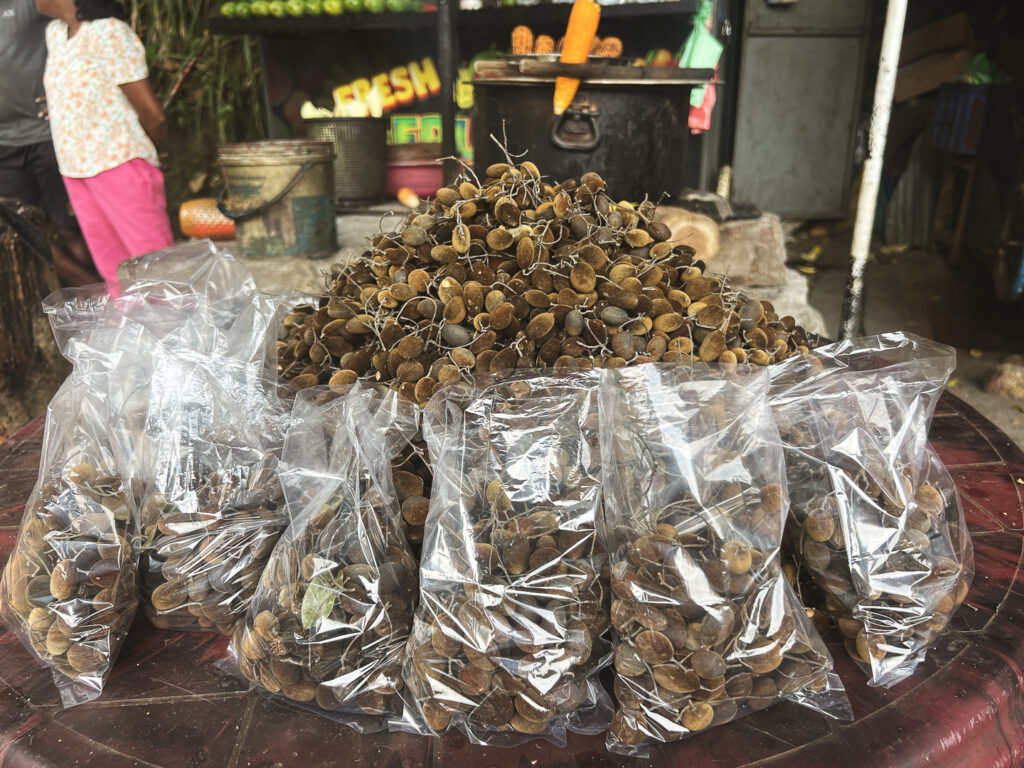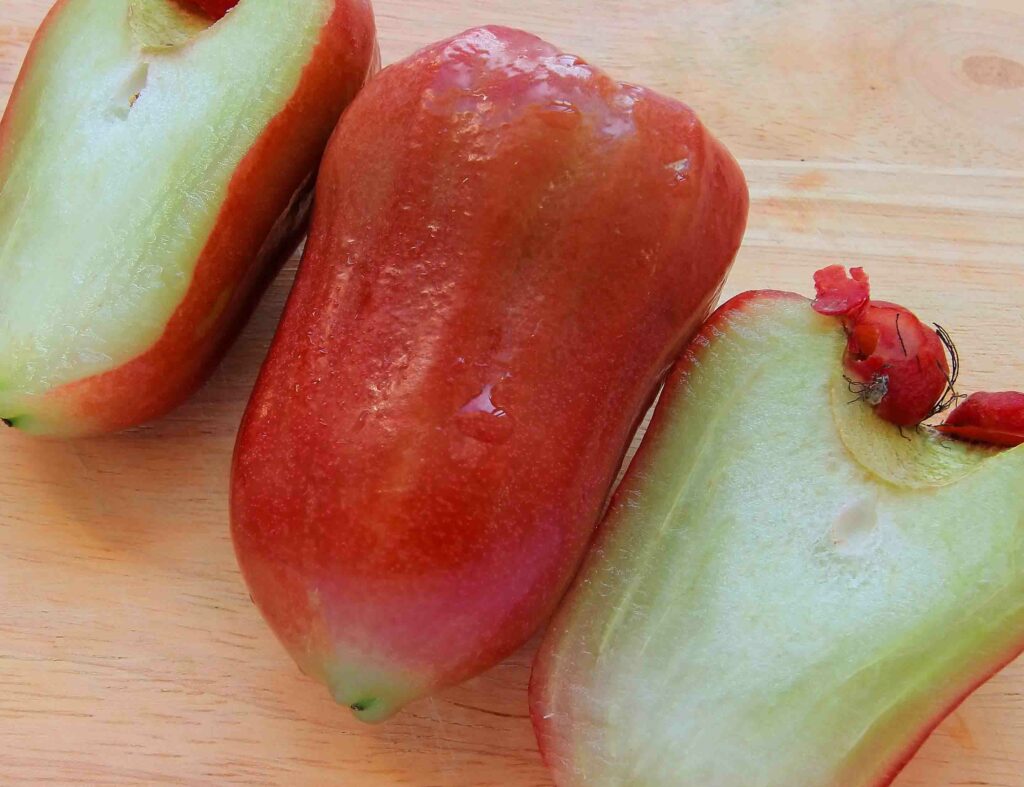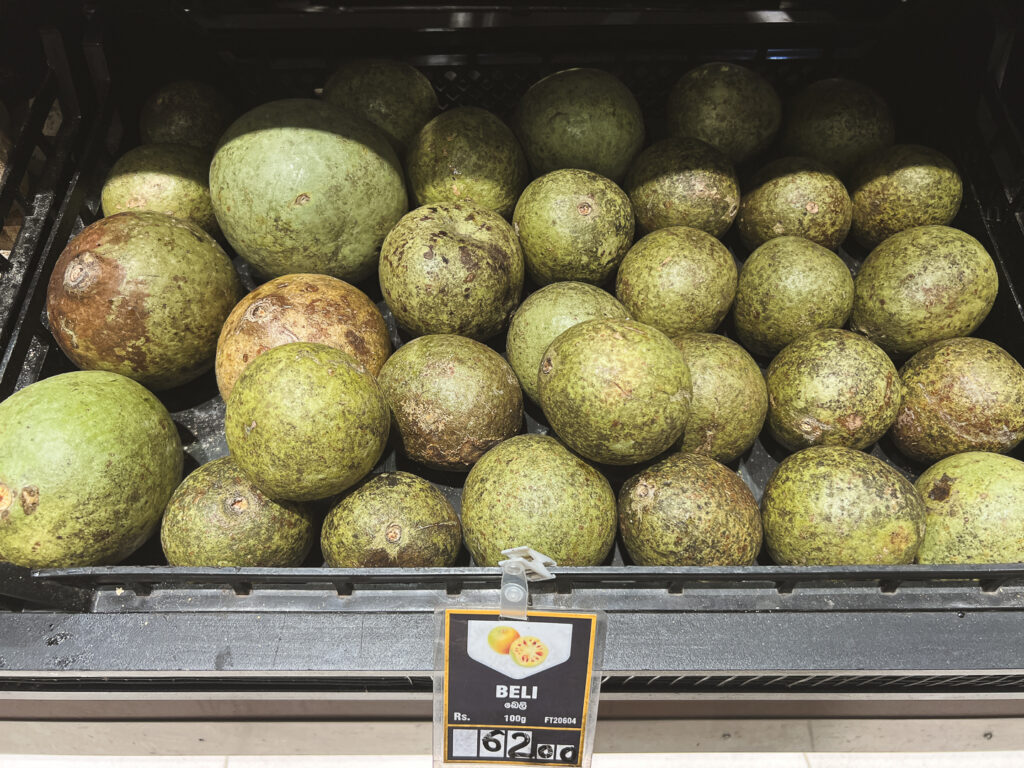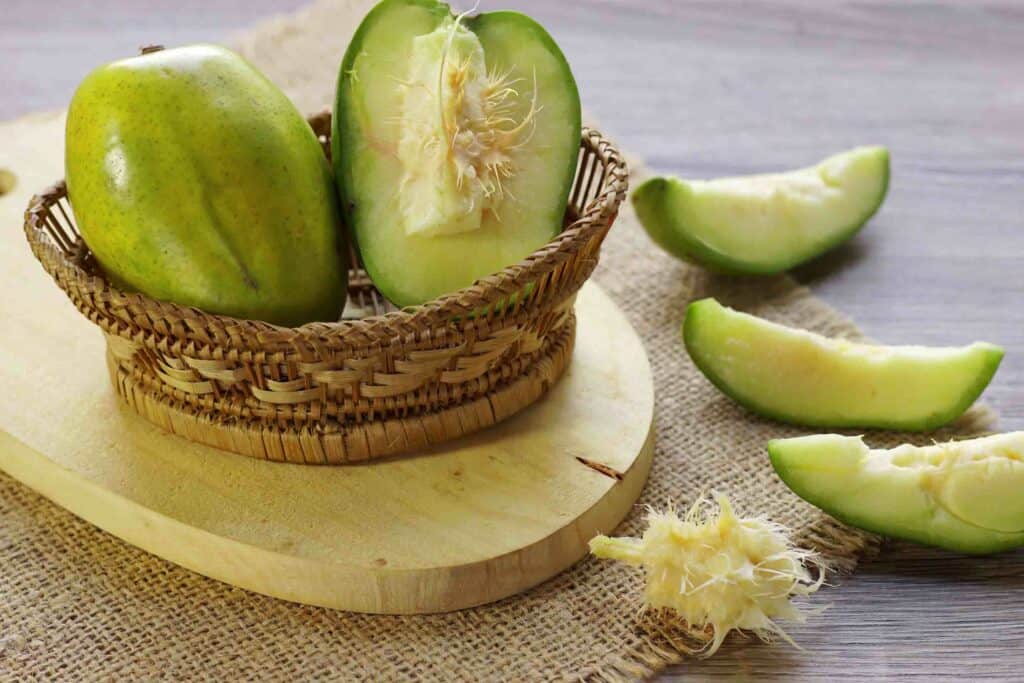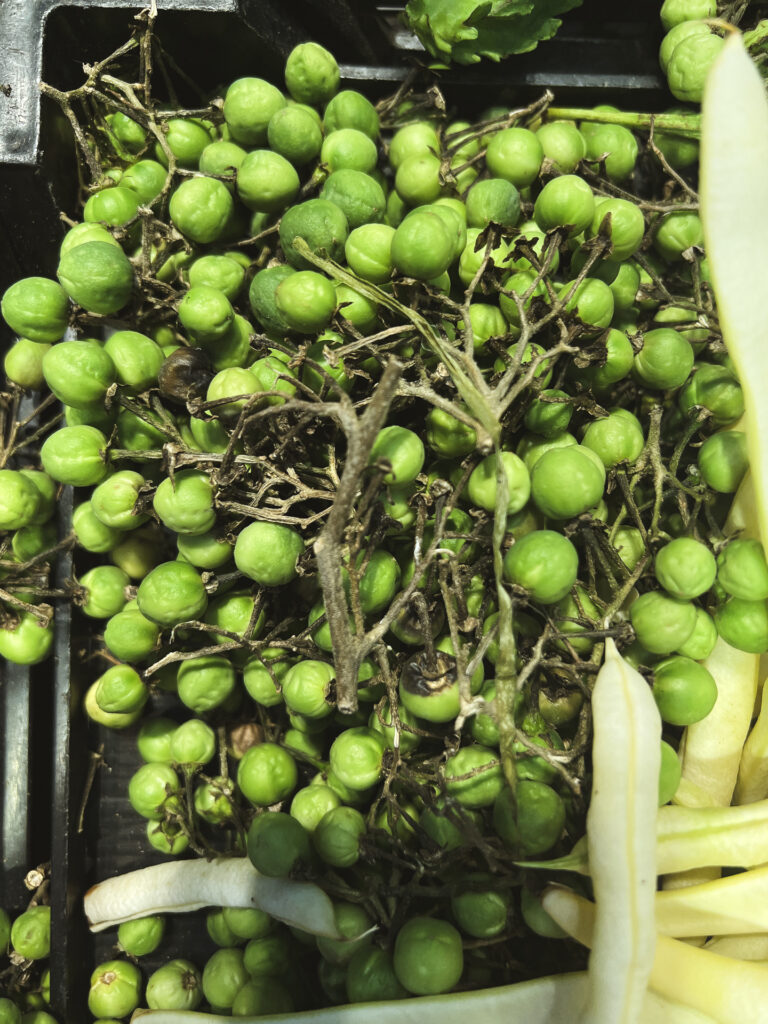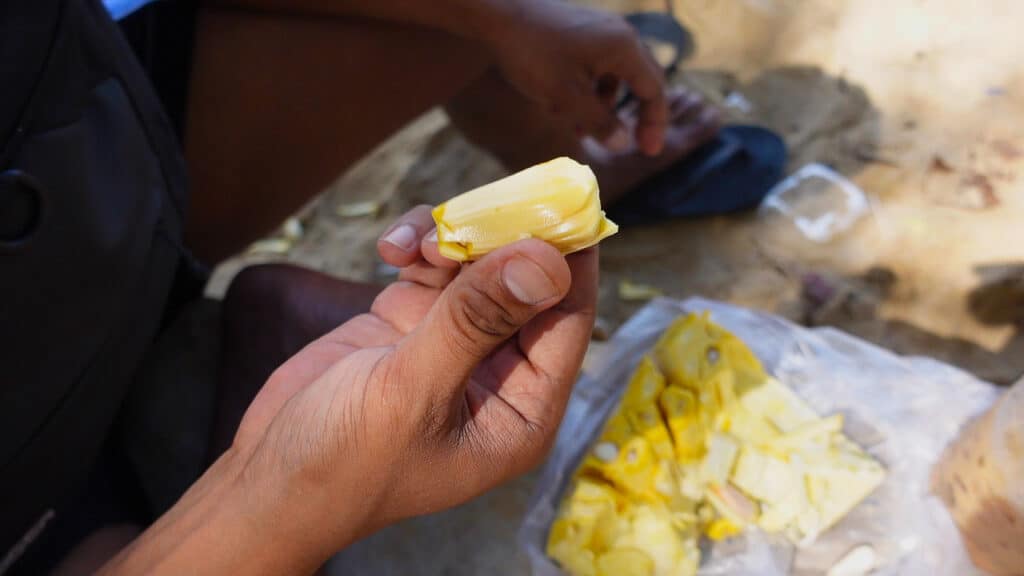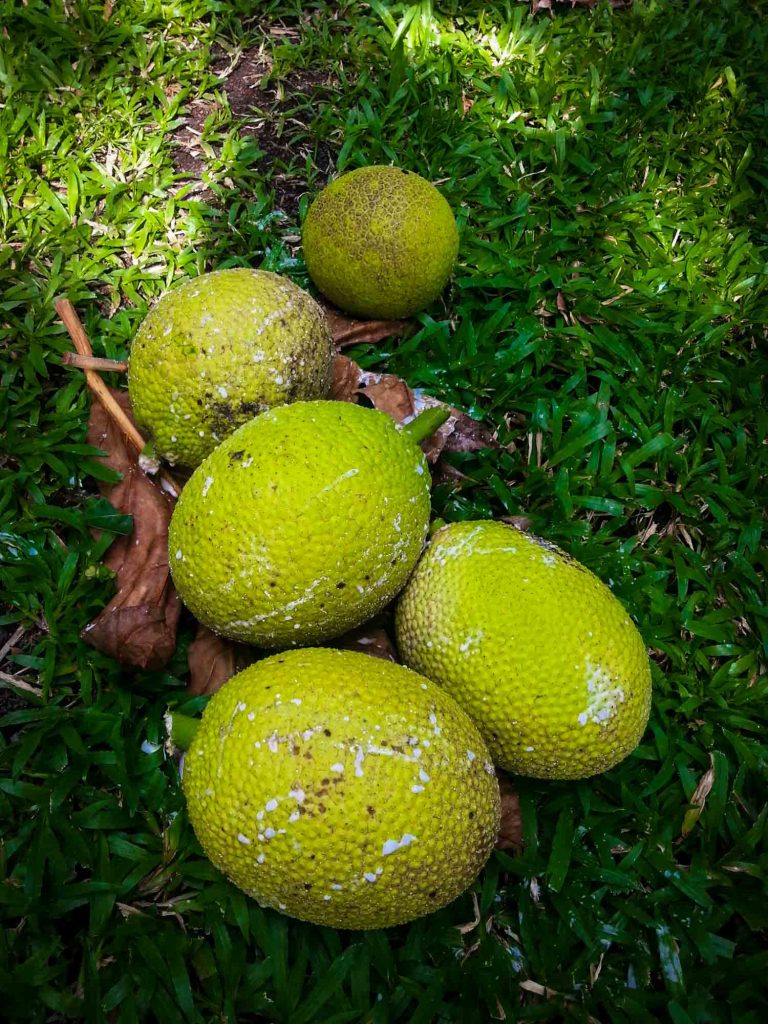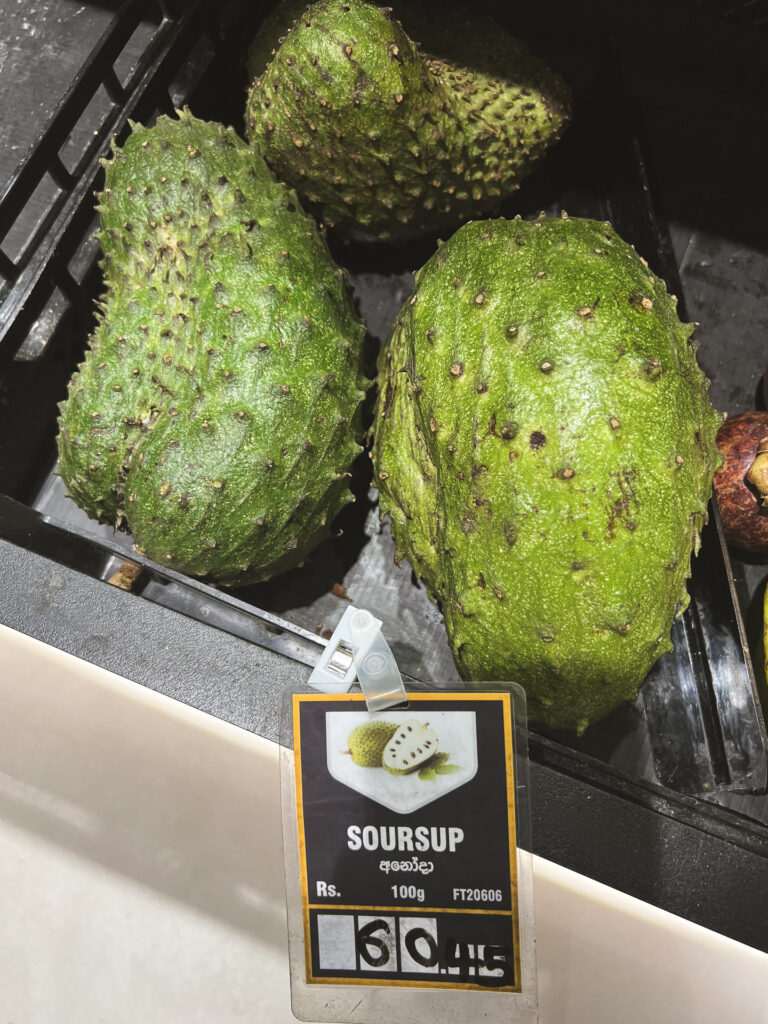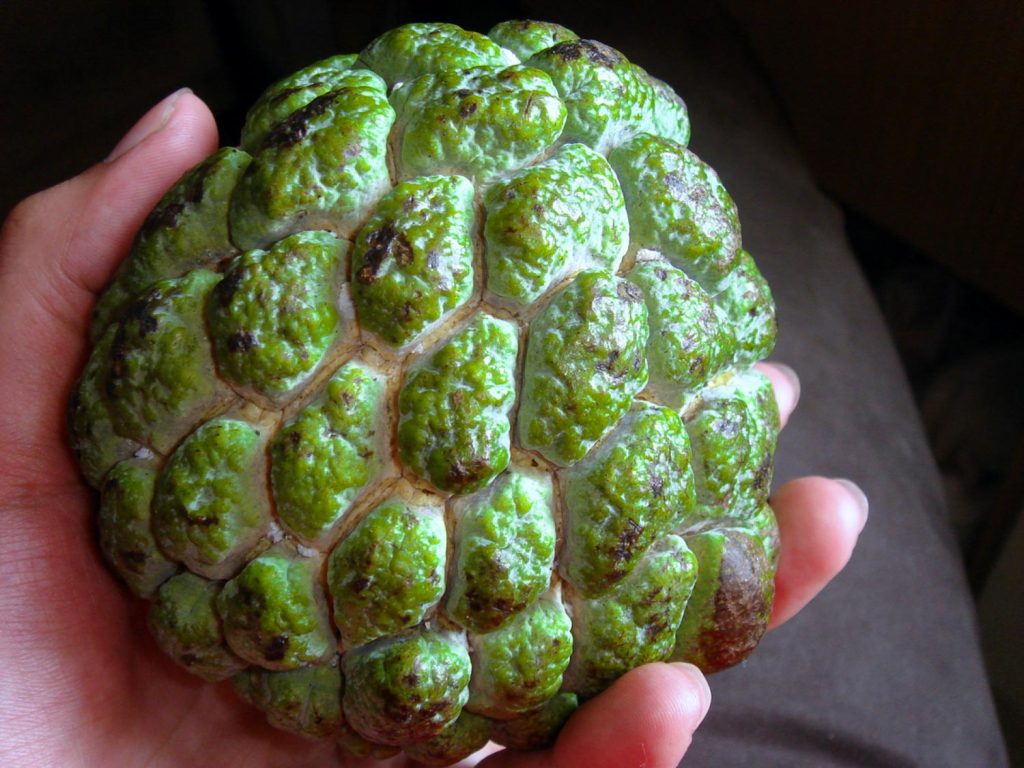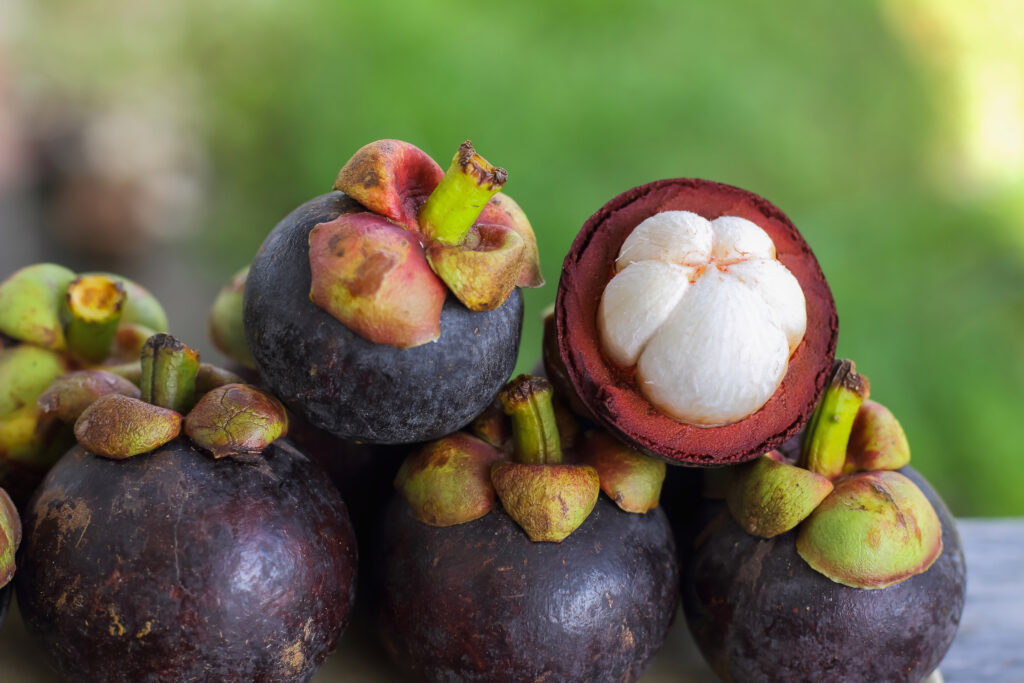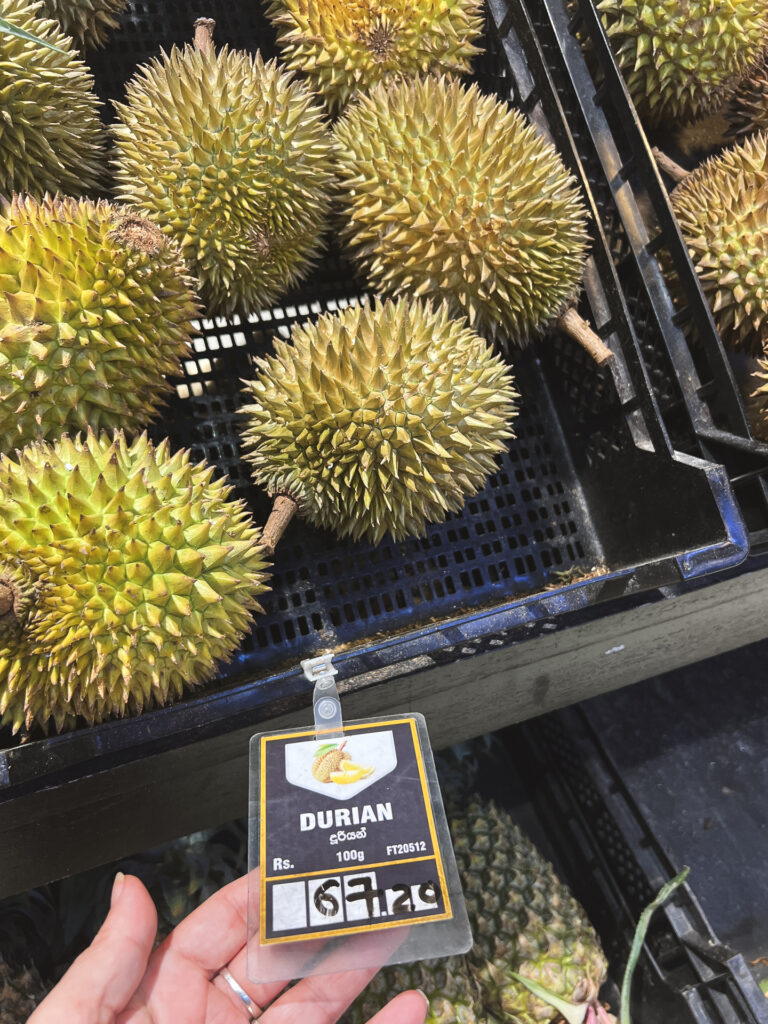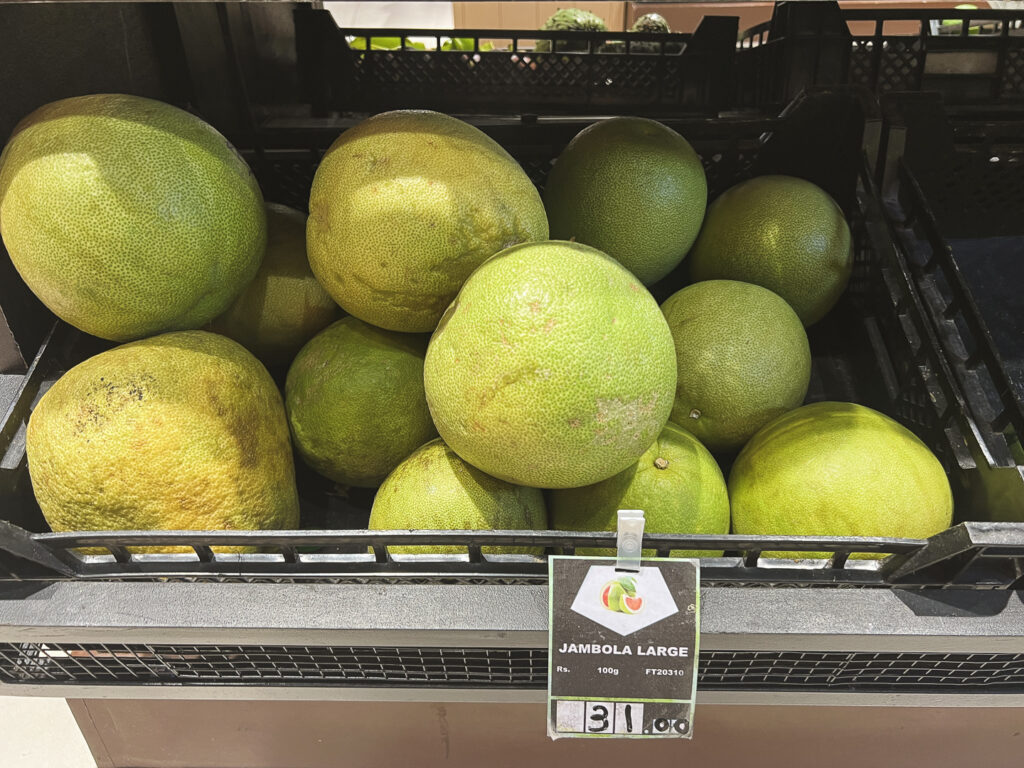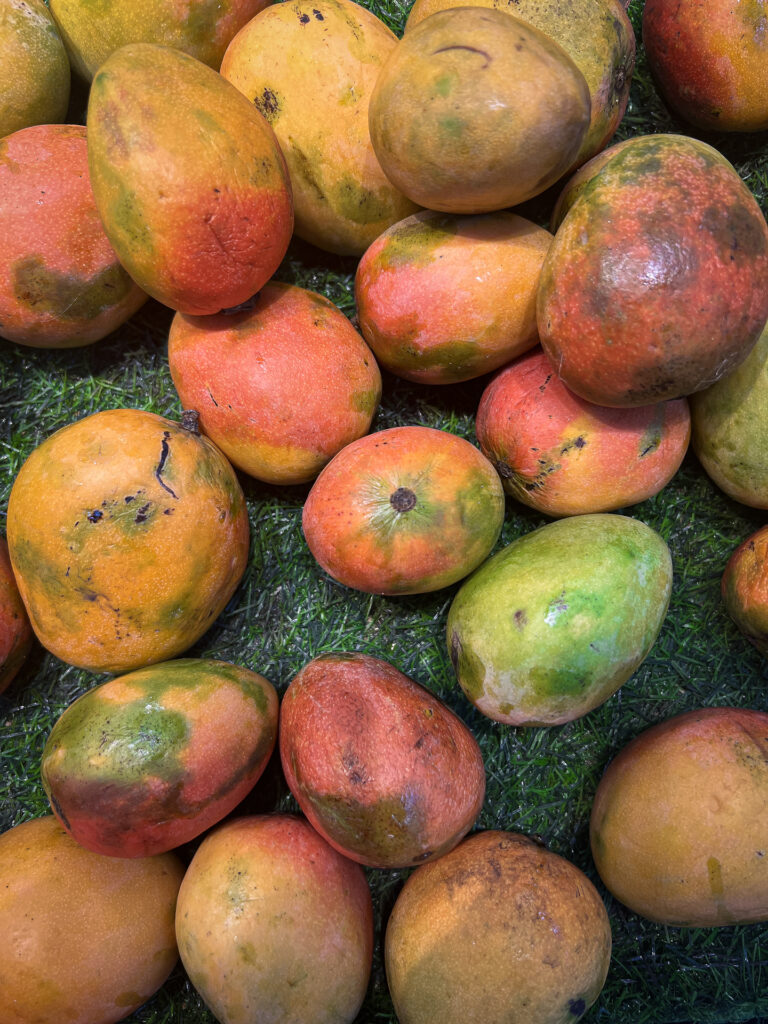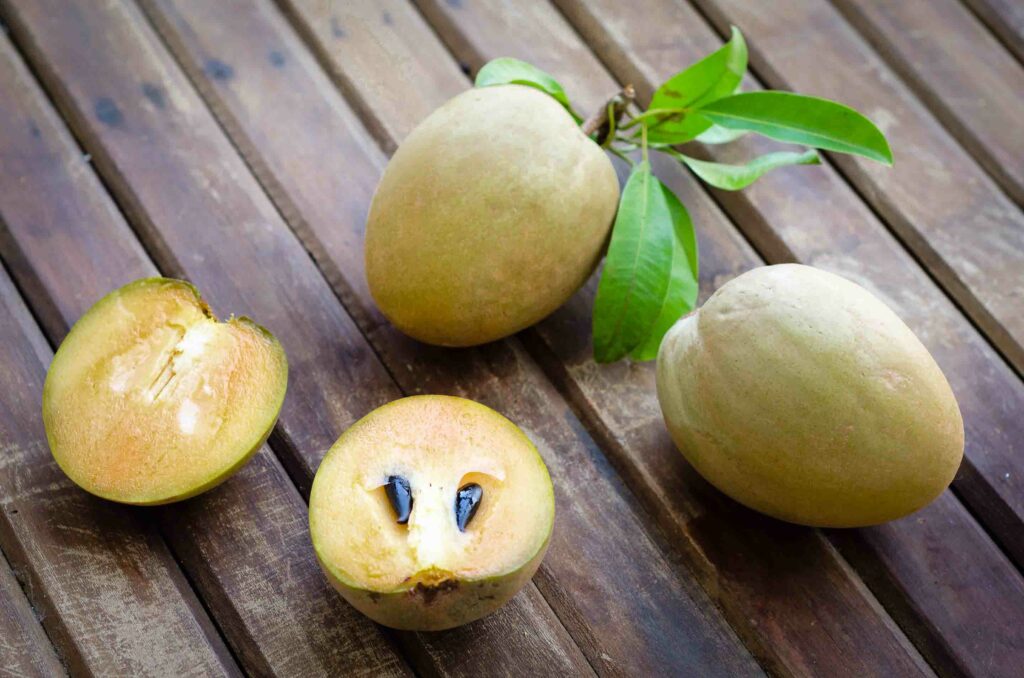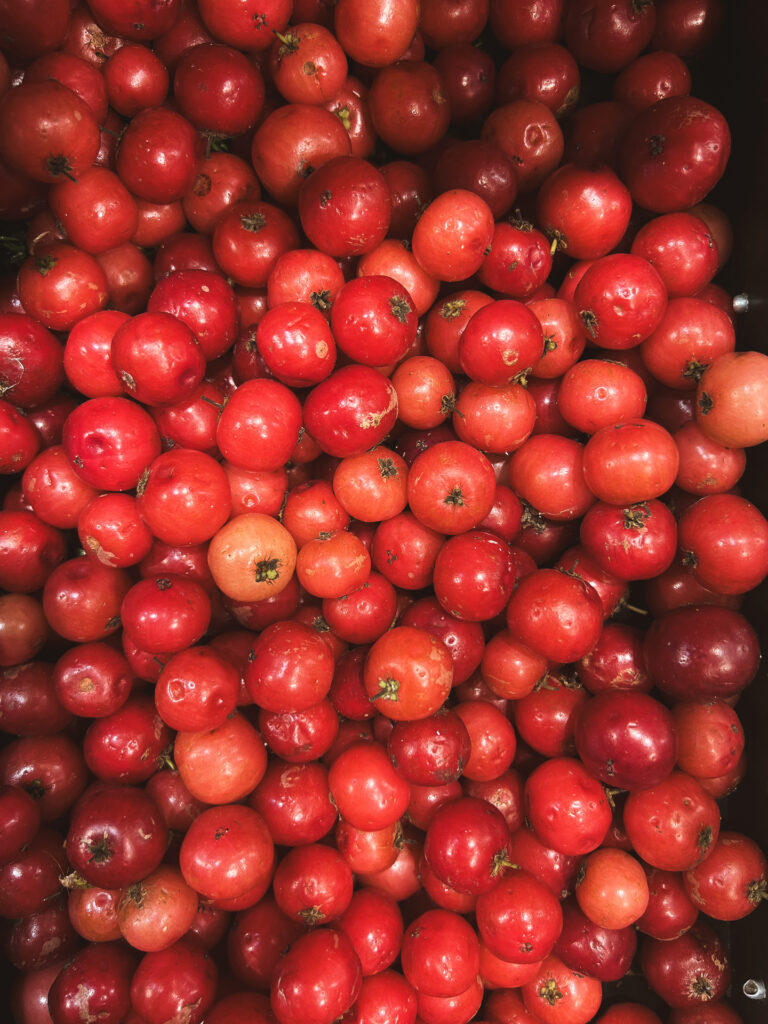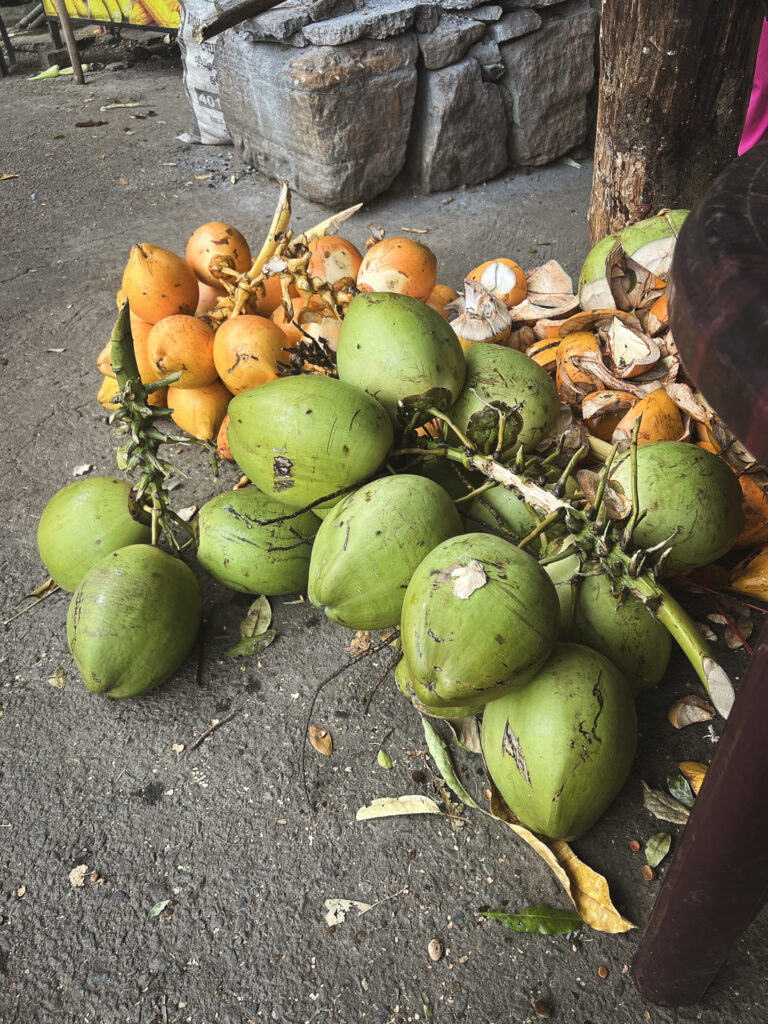It may be a small country but Sri Lankan fruits will surprise you with flavors you’ve never tried before.
Call me a fruit hunter because that is one of my favorite things about travel.
I’ve eaten a lot of fruit around the world. In fact, I usually research in advance so that I’m prepared to ask people where to find specific fruits in season. And these lists end up on this website!
Preparing for this trip I was so excited to see there were many Sri Lanka fruits I had never heard of and do not exist in countries I had visited.
It can be intimidating to try new fruits when you aren’t sure exactly how to eat them. Many Asian fruits require peeling or at least squeezing the fruit until you can get inside.
And it’s tough if the vendor doesn’t speak English. Thankfully in Sri Lanka many people do – especially in Colombo.
Below is my first day exploring Colombo where I look for a tropical fruit that is common in South India and Sri Lanka, but I’ve never seen it anywhere else!
Sri Lankan Fruit in Colombo
In Colombo the street vendors are so kind and will let you try things, but be generous with them in return.
This was just the beginning of many exotic fruits I tried in a month traveling the country. In this list I’ve included the scientific name because I’ve learned so many fruits look similar but are just from the same family.
Also please keep in mind that many of the health benefits are unproven by science so don’t go out and eat kilos of durian to stop the aging process.
This is not medical advice. That said, often it takes a bit of time for modern medicine to catch up to what traditional medicinal practioners knew all along.
I also included what it’s called in other countries as you may recognize it. And the season to find it. Many fruits in Sri Lanka are available all year round but not all.
I tried to only include fruit that are grown here and not imported, like grapes. If you want to be sure you have local grapes ask around for Jaffna grapes.
.Sri Lankan Fruits
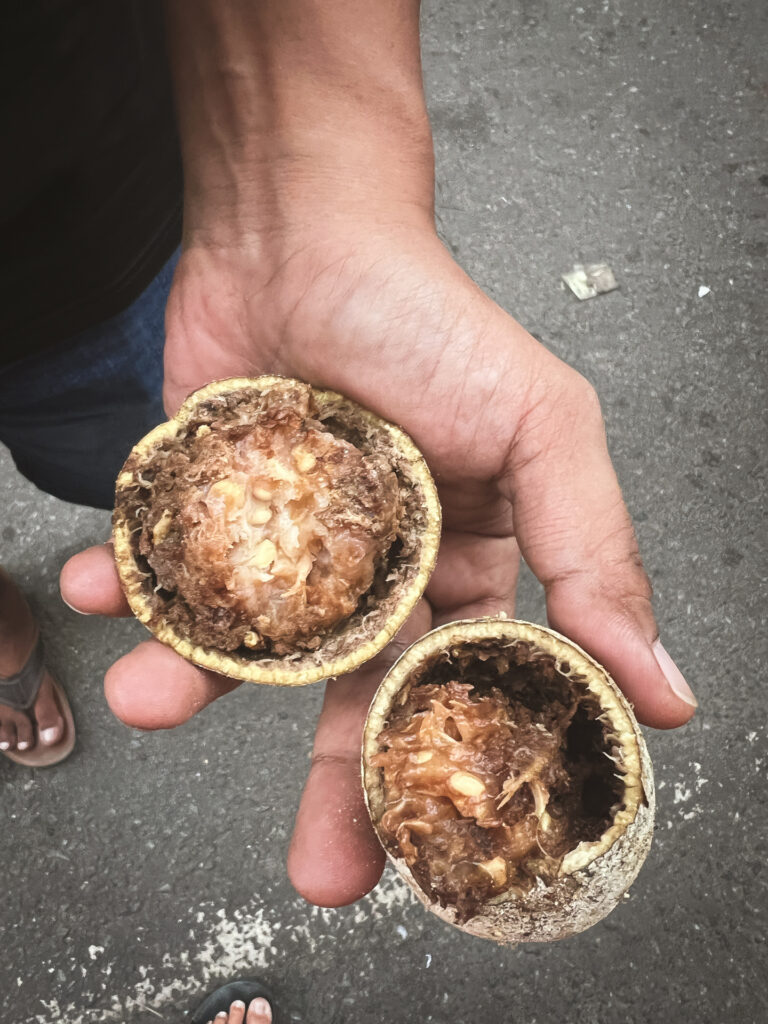
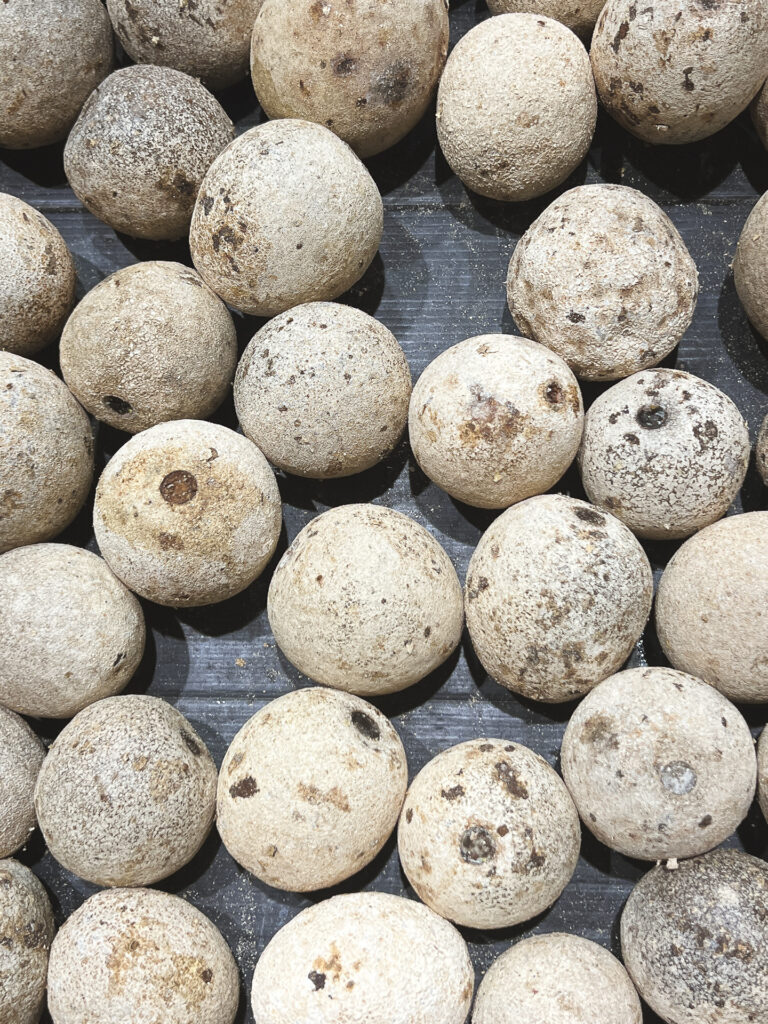
1. Divul | Wood Apple
Wood apple was the first Sri Lankan fruit I wanted to try and so going to the Colombo fruit market was at the top of my list of things to do.
It’s called divul in Sinhala and velanga in Tamil but everyone also knows it as wood apple.
It’s the size of a baseball with a hard, woody shell. Inside there is a sticky, brown pulp inside with a tangy flavor that is similar to tamarind.
At the market the women cracked one open to try but most Sri Lankans mix it with sugar, and sometimes salt along with water. It’s also common to include the seeds in wood apple juice.
Divul is rich in vitamins and minerals. It aids digestion and is used in traditional remedies for diarrhea and dysentery.
Scientific Name: Limonia acidissima
Common Name in other Countries: Elephant Apple
Wood Apple Season in Sri Lanka: May to September
2. Gal Siyambala | Velvet Tamarind
Gal Siyambala or pebble tamarind, is a small, dark fruit encased in a velvety shell. It almost looks like a velvet nut. I first saw it in Colombo but had no idea how to eat it.
At the Nallur Kandaswamy Festival in Jaffna, I discovered they call it silky tamarind or kallu pullium in Tamil. I misunderstood a vendor and thought it was used in curries but I think he was explaining it’s similar to tamarind used in curries.
Instead it’s eaten as a snack and is very popular with kids because it tastes like a sour candy. You pop it open and eat the fleshy fruit off the nut.
Traditional Jaffna Food
Native to Sri Lanka, I did not realize it was also a popular Cambodian fruit available in the countryside but I’m definitely going to look for it again.
Velvet tamarind is high in vitamin C and antioxidants. It’s a powerhouse of a small fruit and helps with everything from constipation to reducing fever.
Scientific Name: Dialium indum
Common Name in other Countries: Black Tamarind, Velvet Tamarind
Pebble Tamarind Season in Sri Lanka: November to March
3. Jambu | Rose Apple
Jambu is not a guava fruit, as known in other countries but actually a rose apple, is a bell-shaped fruit with a crisp, watery texture.
It’s originally from Southeast Asia and common in markets from Laos to Indonesia. But it’s also a popular fruit in Trinidad and Tobago along with other Caribbean countries.
it is packed with vitamins A and C. It helps in hydration and boosts the immune system, which is so welcomed in hot weather.
Scientific Name: Syzygium jambos
Common Name in other Countries: Malabar Plum, Mountain Apple, Water Apple, Malay Apple, Champoo, Chom pu
Jambu Season in Sri Lanka: April to June
Kiribath
4. Veralu | Ceylon Olive
Veralu, or ceylon olive, is a small, yellowish green Sri Lankan fruit with a tart taste like an olive.
It grows in the fertile wet areas of the country, like Kandy, Matale and Ratnapura. It is most commonly eaten raw with a bit of salt and chili.
But sometimes you can find it pickled and traditional Sri Lankan curries use it for a hint of sourness.
Like most Sri Lankan fruits it has vitamin C and fiber. But it’s also known to be good for the skin and collagen production. Locals also believe it helps with cooling and detoxifying the body.
Scientific Name: Elaeocarpus serratus
Common Name in other Countries: Not many but some call it Indian olive
Ceylon Olive Season in Sri Lanka: May to August
5. Beli | Bael Fruit
Beli, also known as bael fruit, has a hard outer shell and inside it smells like roses.
It’s often confused with wood apple but these are two different fruits in Sri Lanka. I include scientific names because it can be very confusing when different fruits are called the same thing in English.
They say you love it or hate bael fruit. Young fruit is more sour and it can almost taste like an orange rind mixed with pepper. It is definitely worth trying.
Native to India and Sri Lanka, it is rich in vitamins A, B, and C. It helps in treating digestive disorders and respiratory issues.
Scientific Name: Aegle marmelos
Common Name in other Countries: Bengal quince, slime apple, stone apple, Japanese bitter orange
Beli Season in Sri Lanka: April to June
6. Ambarella | Hog Plum
Ambarella, or hog plum, is an oval-shaped fruit with a crunchy texture.
It is originally from Polynesia and Melanesia and was brought to Sri Lanka by colonizers. It’s popular in South East Asia but also throughout Africa, Latin America and the Caribbean.
You can eat both the fruit and the leaves. It is crunch and sour when it’s young.
However, I ate ambarella in Kandy in a rice and curry dish and had no idea what it was as it tastes like a pineapple mixed with mango when ripe. It’s delicious.
High in vitamins A B and C, it supports immune health and aids in digestion.
Scientific Name: Spondias dulcis
Common Name in other Countries: Golden apple, June plum, April plum, cas mango
Ambarella Season in Sri Lanka: September to January
7. Thibbatu | Turkey Berry
Thibbatu, also known as turkey berry, is a small, green fruit that grows in clusters.
Although it is a native South American fruit and found all the way north to Mexico I have never seen it there. Perhaps because it can be bitter.
It was introduced to Sri Lanka by South Indian immigrants. In Sri Lanka it’s common in curries and sambols.
It is considered an ayurvedic ingredient used as an anti-inflammatory and can also help with ulcers and many other issues.
Scientific Name: Solanum torvum
Common Name in other Countries: Pea Eggplant
Turkey Berry Season in Sri Lanka: Throughout the year
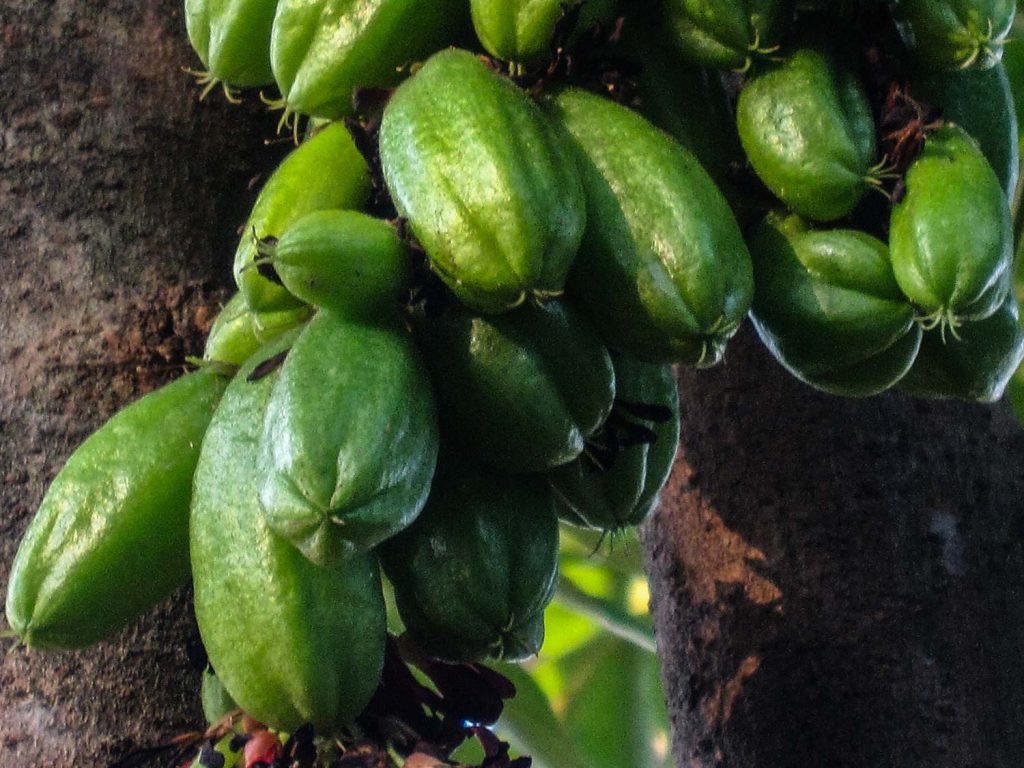
8. Bilimbi | Cucumber Tree
Bilimbi looks similar to a cucumber but grows on a tree and actually doesn’t taste like a cucumber. On the ends it almost has five side, because it’s related to the starfruit as it can also be quite sour.
It is originally from Malaysia and Indonesia and is related to the star fruit tree, which you can see as the ends of the blim blim almost have five sides.
But it has traveled widely and is a popular Costa Rican fruit used in a relish for casados.
Many people have blimbi trees in their backyard and make sambols, chutneys and add it to curries as it’s a bit sour. It makes for a great pickle.
Scientific Name: Averrhoa bilimbi
Common Name in other Countries: Tree sorrel, blil blim, sowry fruit, souri fruit and sour barge
Bilimbi Season in Sri Lanka: Throughout the year
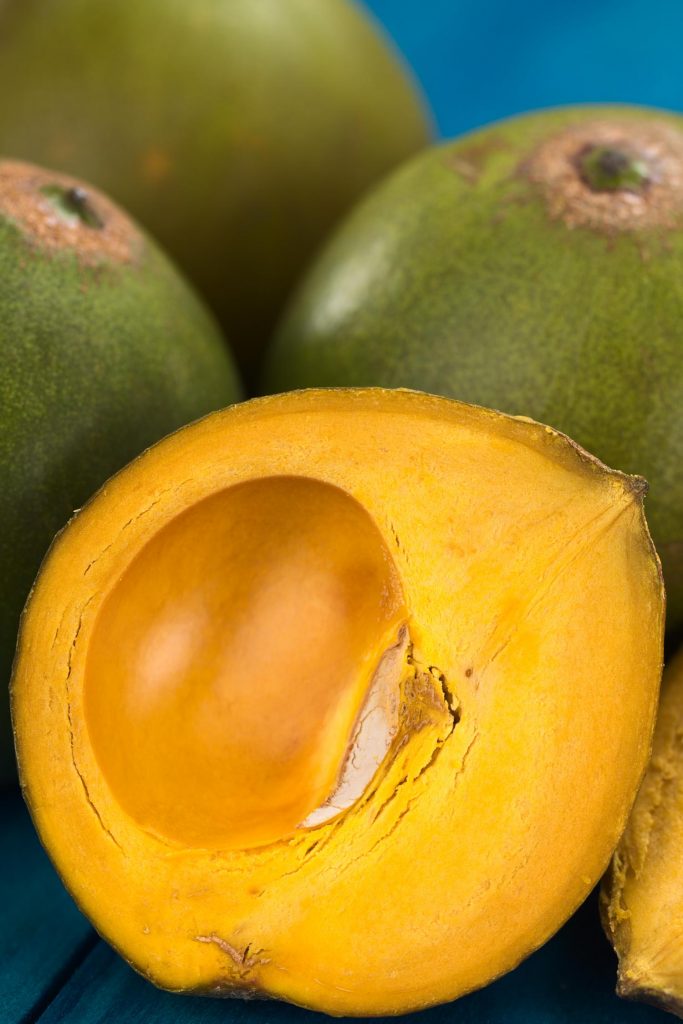
9. Lavulu | Egg Fruit
Lavulu is more common in Sri Lankan’s backyards than it is in the market. It is an underutilized fruit often eaten as a dessert fruit and used in jams and preserves and smoothies.
Native to the country it is another Sri Lankan fruit that is used commonly in traditional medicine in a number of countries to help cough, reduce swelling and some pound the leaves to treat smallpox.
It did makes its way to the Americas where in English it has the unfortunate name of eggfruit, which doesn’t sound appetizing as it only looks like egg.
But the Peru fruit is known as lúcuma and is the national fruit of Peru. This goes to show you how important a name can be!
Lavulu is rich in antioxidants and is a great anti-inflammatory. It is also delicious and you can look for it at juice stands where it’s mixed with coconut milk to make a delicious smoothie.
Scientific Name: Pouteria campechiana
Common Name in other Countries: egg fruit, penny piece, canistel, zapote amarillo
Laulu Season in Sri Lanka: March to September
Ella Restaurants
10. Amla | Indian Gooseberry
Another one of the ayurvedic medicinal plants of Sri Lanka amlas are small, green Sri Lankan fruits with a sour and bitter taste.
Native to India and brought to Sri Lanka but it is used far and wide in Asia as it grows well and is known for many medicinal properties from treating diabetes to STIs. In Sri Lanka it’s commonly used to help with hyperglycemia.
It’s used in dals or soaked in syrup to eat as something sweet after a meal. But the whole tree can be used, in Sumatra Indonesia they use the inner bark in a soup.
Scientific Name: Phyllanthus emblica
Common Name in other Countries: Nelli, emblic, Malacca tree
Amla Season in Sri Lanka: November to February
11. Kos | Jackfruit
Jackfruit is the national fruit of Sri Lanka. And it’s np surprise as you will see it on every menu.
It is one of Asia’s many large, spiky fruits with yellow flesh. In fact it is so big that at markets it is cut into more manageable sizes to eat.
One of my favorite exotic fruits, kos is like a delicious fruit cup all in one bite when eaten raw.
You can eat jackfruit fresh and it tastes like strawberry, apple, banana. But in Sri Lanka unripe or green jackfruit is known as polos and used in everything from fritters to curries.
It is delicious and most devote carnivores would swear they are eating meat.
Native to South Asia, it is rich in vitamins A and C. It supports immune health and aids in digestion.
Scientific Name: Artocarpus heterophyllus
Common Name in other Countries: Jakfruit, jack, jake tree, Nangka
Jackfruit Season in Sri Lanka: March to June
12. Del | Breadfruit
Del, or breadfruit is related to jackfruit as they are both members of the mulberry family.
Native to the Pacific Islands, it was brought to Sri Lanka by colonizers. I first discovered it in Maui where the Hawaiian fruit is known as ulu. There is an entire Breadfruit Institute there dedicated to the study and preservation of this fruit.
It is also the most famous Barbadian food, known as cou-cou and part of the national dish served with flying fish.
Breadfruit is another large, green fruit but it has a starchy texture and is one of the most underrated fruits in the world as it could help with food insecurity.
It smells like bread and can be used any way you eat a potato. It helps with obesity and diabetes as it is low on the glycemic index. Also, it is healthier because the micronutrients are higher than rice and there is more potassium than taro.
Best of all, it grows like a weed and needs little maintenance.
In Sri Lankan breadfruit is often eaten boiled or in curries. If you can find an overripe breadfruit crack it open as it becomes creamy like a custard.
Scientific Name: Artocarpus altilis
Common Name in other Countries: Cou-cou, ulu, sukun, masapan, suku, panapén, kamansi, kulur, kelor
Breadfruit Season in Sri Lanka: June to September
13. Katu Anoda | Soursop
You’re going to see a lot of spiky green fruit in Sri Lanka, and that’s a good thing as they are delicious but also bursting with vitamins and other great health properties.
Katu anoda, known as soursup, also a spiky green exterior and creamy white flesh. It is native to the Caribbean where it’s a common Cuban fruit but can be found all over the world.
It tastes like a mix of strawberry, apple, kiwi and is delicious raw. But also used in smoothies in Sri Lanka.
Around the world, including Sri Lanka, it is believed to cure a number of serious ailments including cancer.
Scientific Name: Annona muricata
Common Name in other Countries: Graviola, guanabana, guyabano, lakshman phal
Soursop Season in Sri Lanka: June to September
14. Anona | Custard Apple
Another member of the anona family, but without spikes. or custard apple, has a bumpy green skin and sweet, creamy flesh. It’s also known as seeni aththa in Sinhala and sitapallun in Tamil.
Anona is originally from the Caribbean and one of the most popular Jamaican fruits.
Anona is often confused with sweetsop/cherimoya which looks so similar but sweetsop is annona cherimola. They look slightly different but have the same creamy fruit cup taste. So you can’t go wrong with either.
This family of Sri Lankan fruits has been studied all over the world as there are a number of anti-cancer properties along with other serious diseases.
And its benefits are not only in the fruit as the ground seed appears to help with lice and extracts from the leaf help ulcers.
Nothing is 100% proven but it’s being studied by enough scientists that I always choose juice from this family when possible.
Scientific Name: Annona squamosa
Common Name in other Countries: Sugar apple, noi-na, anon
Anoda Season in Sri Lanka: August to November
15. Heen Bōmbu | Wild Mangosteen
This fruit is only found in Sri Lanka, which is incredible considering how fruits are usually native in one country but brought to others.
Heen bōmbu or wild mangosteen, is a small, reddish purple fruit with a sweet-tart flavor.
Not only is the fruit used but also the bark and seeds as it’s useful for treating a number of things from heart disease to hemorrhoids and asthma.
Unfortunately it’s on the red list of endangered plants so it’s unlikely you’ll find it. The good news is that there are conservation efforts to revive it.
Scientific Name: Garcinia quaesita
Common Names: Wild Garcinia
Heen Bōmbu Season in Sri Lanka: August to November
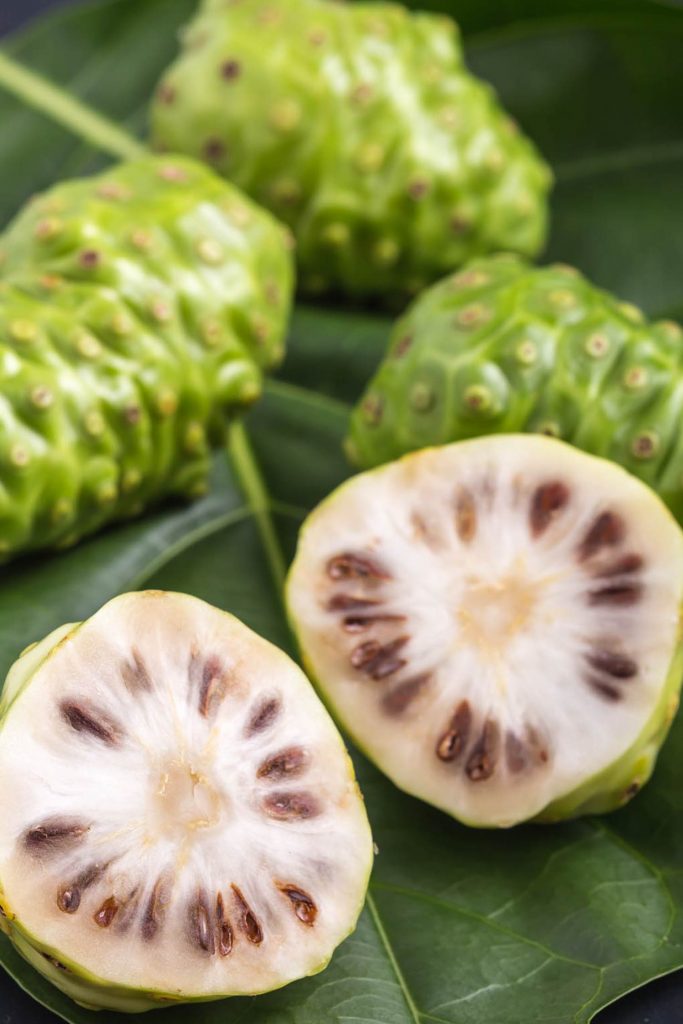
16. Noni or Ahu | Indian Mulberry
One of the most interesting fruits, noni is native to Southeast Asia and Australasia, it was introduced to Sri Lanka through trade routes.
However, it can be found around the world, known as the miracle fruit noni. Like most miracle fruits it can be difficult to eat.
I saw lots of noni trees, which are beautiful shade trees, throughout Sri Lanka in people’s yards and just on the street. You’d think they are free for the taking!
If you think durian is bad, noni is even worse because both the smell and the taste are terrible. Think stinky rotten cheese or moldy feet.
It is rich in vitamins C and E, as well as potassium and antioxidants. It supports immune health, reduces inflammation. But around the world, many cultures believe it can cure cancer and other serious illnesses.
I first discovered it in Hawaii where everyone loves it but no one eats it. A small portion is often mixed into smoothies or juices with other tropical fruits to mask the flavor. You may also find it in Sri Lankan soups.
And it’s becoming more popular as supplements in the western world. If you’re interested in trying Amazon sells these noni pills.
Scientific Name: Morinda citrifolia
Common Name in Other Countries: Great morinda, inda, cheese fruit, mengkudu besar
Noni Season in Sri Lanka: Throughout the year
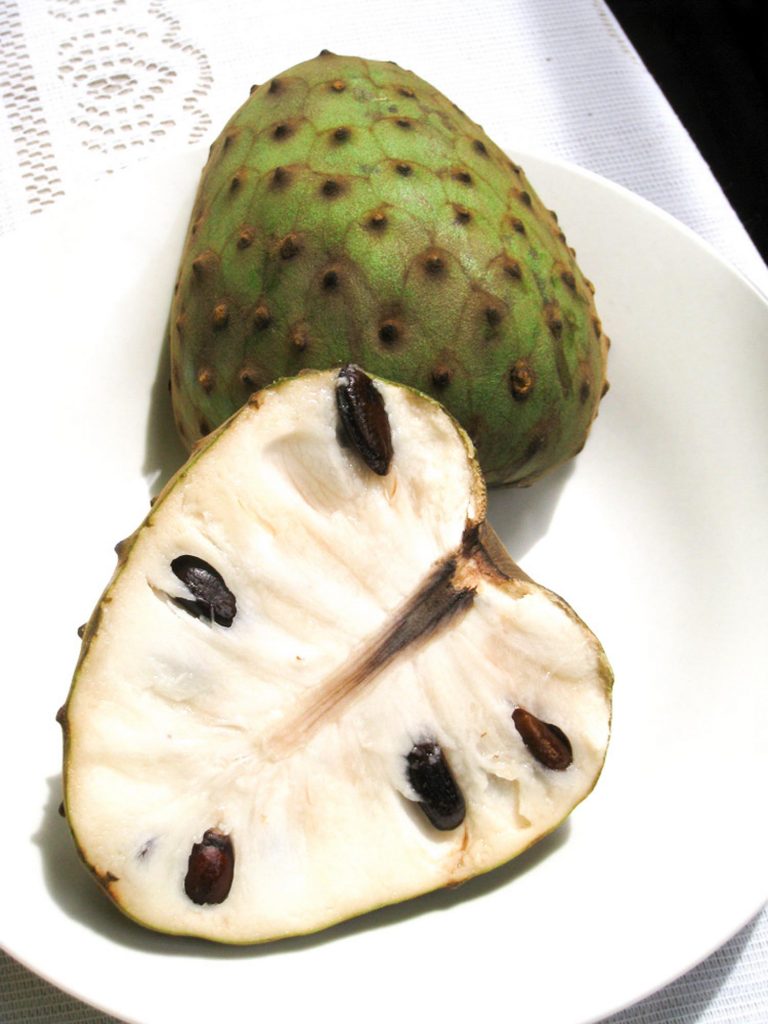
17. Vali Anoda | Cherimoya
Wali anoda or cherimoya, has a green, scaly skin and creamy, sweet flesh. It’s in the same family as the custard apple and tastes quite similar.
Native to the Andes it is a very popular Ecuadorian fruit.
In Sri Lanka it is known as the ice cream fruit as it is delicious cold. It’s also one of the ayurvedic plants as it is rich in vitamins B and C, supporting brain health and immunity amongst other things.
Scientific Name: Annona cherimola
Common Name in other Countries: Custard apple, chirimorrinon, chirimuya, cabeça-de-negro, anona do Chile
Cherimoya Season in Sri Lanka: November to February
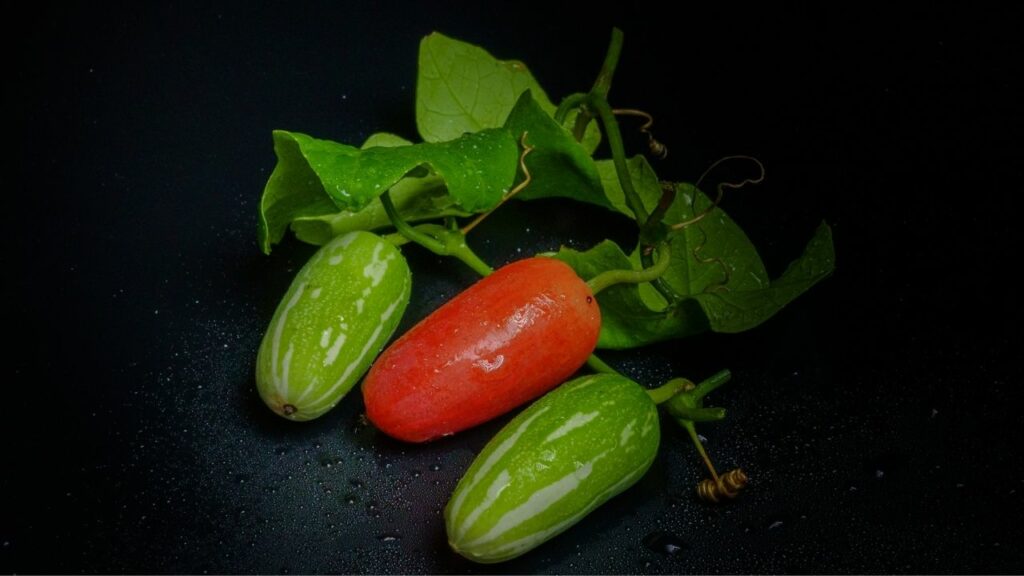
18. Kowakka | Ivy Gourd
Kowakka, also known as ivy gourd, is a small, green fruit with a crunchy texture. It looks similar to a cucumber until it ripens on a vine to a bright red.
One of the more unique Sri Lankan fruits, both the fruit and young leaves are used in porridge and curries as well as the shredded vegetable dish known as mallung..
Native to South Asia, it is rich in vitamins A and C. It supports eye health and boosts immunity. The root and stalk are also made into a juice to help with aches and pain.
Scientific Name: Coccinia grandis
Common Name in other Countries: Scarlet gourd, tindora, baby watermelon and kowai fruit
Ivy Gourd Season in Sri Lanka: Throughout the year
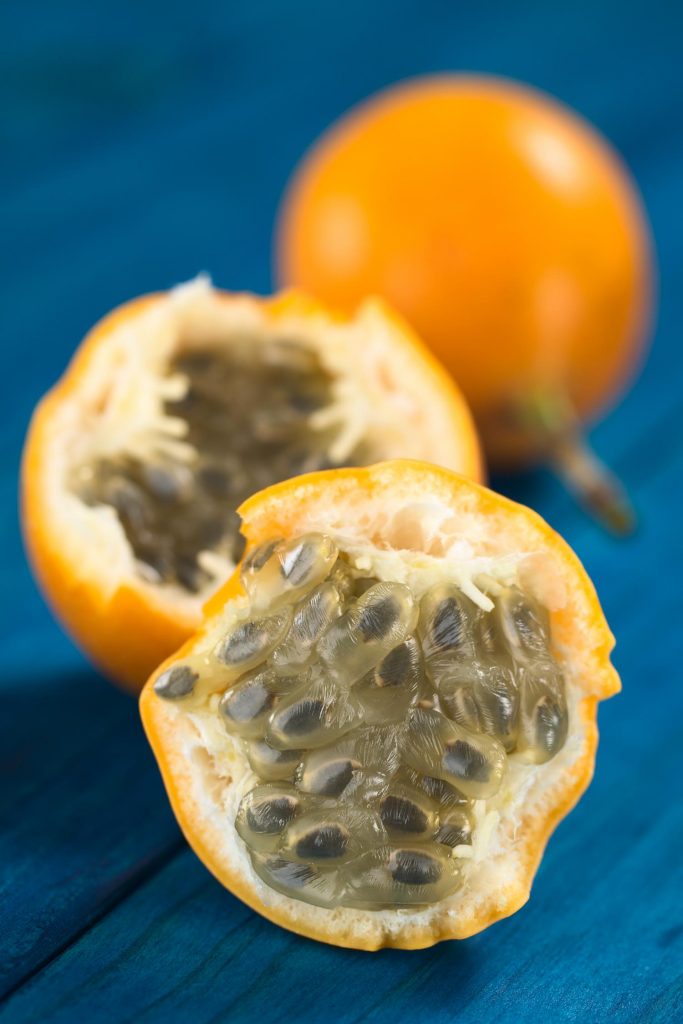
19. Kambolaa | Passion Fruit
Passion fruit is one of the most popular fruits in Sri Lanka.
It has a tough outer yellow rind that you do not eat. Inside it has very tart and has somewhat slimy seeds, which is what you eat.
I love throwing it in plain yogurt, but in Sri Lanka it’s more common as a juice, cordial or jam. Beware in order to combat the tart flavor they add a lot of sugar.
It’s native to South America and was one of the first Colombian fruits I tried and immediately loved because it was like nothing I knew in Canada.
It is high in vitamins A and C, supporting immune health and skin.
Scientific Name: Passiflora edulis
Common Name in other Countries: Maracuja, grenadelle, grenadine
Passionfruit Season in Sri Lanka: May to August
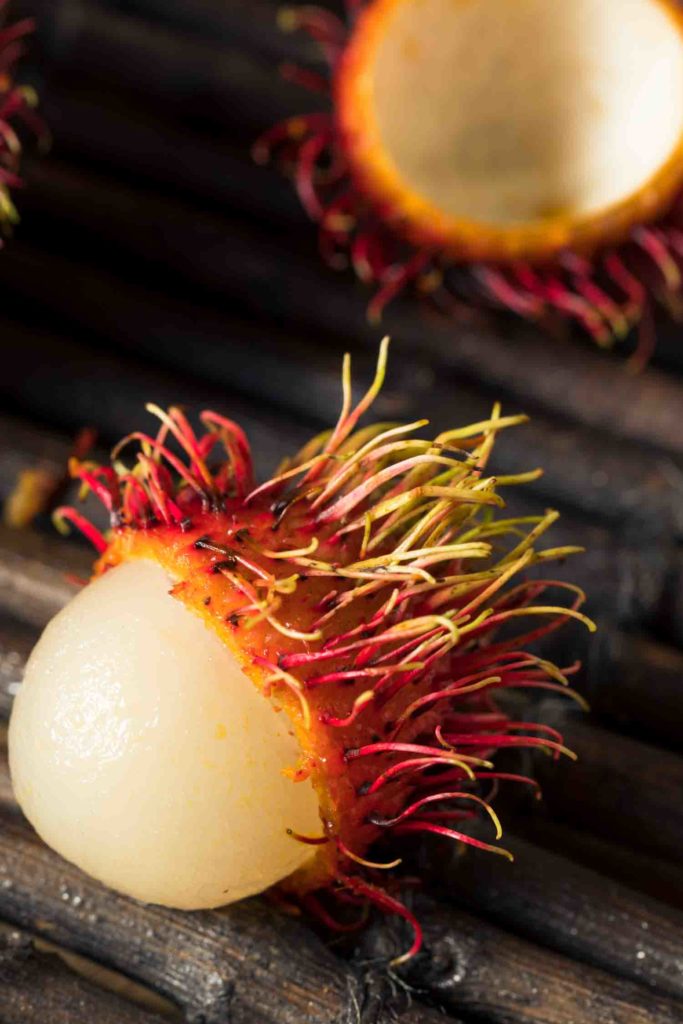
20. Rambutan
Rambutan is one of my favorite fruits and I was sad I had missed rambutan season.
Its name refers to its hairy exterior. You squeeze the fruit and it easily breaks open for sweet fruit flesh. Beware there’s a nut inside so pop it in your mouth and eat around it.
If you’re buying rambutan in the market look for bright red fruit that don’t look dry. Rambutan does not continue to ripen after picked so if it’s not bright red with little yellow it’s not the best.
Don’t be shy about asking the vendor for the best ones, if not you may get some yellow ones thrown in. They are perfect for a long bus or train ride.
Rambutan is native to Southeast Asia, it is rich in vitamins C and B. It supports skin health and boosts immunity.
Scientific Name: Nephelium lappaceum
Common Name in other Countries: Chôm chôm, ngaw, phruan
Rambutan Season in Sri Lanka: June to August
21. Mangus | Mangosteen
Mangosteen is known as the queen of fruits in many countries, including Sri Lanka.
It has a thick purple rind that almost looks like leather. Many tourists are intimidated by this Sri Lankan fruit as the skin is so thick they don’t realize it needs to be squeezed open to find the juicy, white segments.
Pro tip: some times you need to squeeze really hard with both hands. Don’t worry it’s firm inside.
Native to Southeast Asia and a very popular street fruit in Vietnam, mangosteen is rich in vitamins C and E. It supports immune health and has anti-inflammatory properties.
Scientific Name: Garcinia mangostana
Common Name in other Countries: Purple mangosteen, manggis, mesetor, sementah, semetah
Mangosteen Season in Sri Lanka: May to August
22. Durian
Throughout Asia, the most celebrated and hated fruit is this large fruit with a spiky shell and strong odor.
It’s so strong you’ll find lots of signs telling you not to bring it into a hotel, restaurant and in a taxi your driver will ask you to hang it out the window.
I have been trying to eat durian in every country because like apples there are many varieties and if you don’t like one you should keep trying.
So far Thai durian wins, as the one I tried was yellow and fruity, instead of the slimy white ones most Indonesians love.
What I appreciate in Sri Lanka is that they not only eat it raw but also incorporate it into curries, desserts and other traditional food.
Unfortunately, I wasn’t there to try the Sri Lankan varieties but that’s just a good reason to come back.
I am starting to think the smellier the fruit the better it is for you. There is a long list of why you should eat durian:
- Boost energy
- Prevent cancer
- Slow aging
- Lower blood pressure
- Improve immune system
- and so much more
Scientific Name: Durio zibethinus
Common Name in other Countries: King of Fruits
Durian Season in Sri Lanka: June to August
23. Jambola | Pomelo
Jambola or pomelo is the largest citrus fruit with thick rind and juicy segments. Although it looks like a big green grapefruit it is not as tart, and often has a mild taste.
In Sri Lanka it is often eaten as dessert with a bit of sugar.
Native to Southeast Asia, for some reason in Indonesia it is known as Bali orange even though it’s not from there. it is high in vitamin C like most citrus fruits but also a big source of potassium.
Scientific Name: Citrus maxima
Common Name in other Countries: Shaddock, Bali orange, limau betawi
Pomelo Season in Sri Lanka: November to March
24. Karuthakolomban | Jaffna Mango
Next to bananas, mangos are the most commonly grown fruit in Sri Lanka.
Of course you can eat them raw, drink them in juice or have as a dessert. But the most interesting use are with unripe green mangos, which are cooked in curries, chutneys or pickled.
Whatever you do, don’t miss out on the Jaffna Mango. From the north of Sri Lanka it’s a bit smaller but is so sweet.
They are so good they are exported to South India but you won’t find them in your home country so eat as much as you can here.
Scientific Name: Mangifera indica
Common Name in other Countries: KC mangoes, Karthcolomban mangoes
Jaffna Mango Season in Sri Lanka: May to August
25. Sepathilla | Sapodilla
Sepathilla or sapodilla, is a small, brown fruit with sweet, grainy flesh.
It is native to Central America and is my favorite Guatemalan fruit and known as chico zapote. It was the first fruit I had tasted that wasn’t sweet. Instead it’s almost like a malty brown sugar pie filling.
In Sri Lanka they are almost always eaten fresh. Sepathilla is high in vitamins A and C, supporting skin health and digestion.
Scientific Name: Manilkara zapota
Common Name in other Countries: Rata-mi, seemi llupai, chikoo, ciku, naseberry, menila, nispero,
Sapodilla Season in Sri Lanka: November to June
26. Lovi | Ceylon Cherry
Lovi, also known as lovilovi, is a small, red fruit with a tangy taste that is almost too sour to eat raw.
These tiny Sri Lankan fruit are actually native Indonesian and Filipino fruits rich in vitamin C and antioxidants. It supports immune health and aids in digestion.
It’s often cooked with plenty of sweetener into chutney and jams.
Scientific Name: Flacourtia inermis
Common Name in other Countries: Batoko plum, tome-tome, lobi-lobi
Lovi Season in Sri Lanka: April to June
27. Thambili | King Coconut
Thambili, also known as King Coconut might be the most famous Sri Lankan fruit. It is a bright orange variety of coconut native to Sri Lanka. Because of colonization you can also find this fruit in Indonesia and India.
The coconut water is sweeter yet has less sugar content and it also has more electrolytes and essential nutrients than green coconuts. Although it does have less meat inside.
Scientific Name: Cocos nucifera var. aurantiaca
Common Name in other Countries: King Coconut
When Fruit is in Season: Throughout the year
